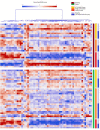Reactome pathway analysis from whole-blood transcriptome reveals unique characteristics of systemic sclerosis patients at the preclinical stage
- PMID: 38022564
- PMCID: PMC10654742
- DOI: 10.3389/fimmu.2023.1266391
Reactome pathway analysis from whole-blood transcriptome reveals unique characteristics of systemic sclerosis patients at the preclinical stage
Abstract
Objective: This study aims to characterize differential expressed pathways (DEP) in subjects with preclinical systemic sclerosis (PreSSc) characterized uniquely by Raynaud phenomenon, specific autoantibodies, and/or capillaroscopy positive for scleroderma pattern.
Methods: Whole-blood samples from 33 PreSSc with clinical prospective data (baseline and after 4 years of follow-up) and 16 matched healthy controls (HC) were analyzed for global gene expression transcriptome analysis via RNA sequencing. Functional Analysis of Individual Microarray Expression method annotated Reactome individualized pathways. ANOVA analysis identified DEP whose predictive capability were tested in logistic regression models after extensive internal validation.
Results: At 4 years, 42.4% subjects progressed (evolving PreSSc), while the others kept stable PreSSc clinical features (stable PreSSc). At baseline, out of 831 pathways, 541 DEP were significant at a false discovery rate <0.05, differentiating PreSSc versus HC with an AUROC = 0.792 ± 0.242 in regression models. Four clinical groups were identified via unsupervised clustering (HC, HC and PreSSc with HC-like features, PreSSc and HC with PreSSc-like features, and PreSSc). Biological signatures changed with disease progression while remaining unchanged in stable subjects. The magnitude of change was related to the baseline cluster, yet no DEP at baseline was predictive of progression. Disease progression was mostly related to changes in signal transduction pathways especially linked to calcium-related events and inositol 1,4,5-triphosphate metabolism.
Conclusion: PreSSc had distinguished Reactome pathway signatures compared to HC. Progression to definite SSc was characterized by a shift in biological fingertips. Calcium-related events promoting endothelial damage and vasculopathy may be relevant to disease progression.
Keywords: disease progression; gene expression; pathways; preclinical systemic sclerosis; systemic sclerosis.
Copyright © 2023 Bellocchi, Wang, Lyons, Marchini, Lorini, Carbonelli, Montano, Assassi and Beretta.
Conflict of interest statement
The authors declare that the research was conducted in the absence of any commercial or financial relationships that could be construed as a potential conflict of interest.
Figures


References
-
- van den Hoogen F, Khanna D, Fransen J, Johnson SR, Baron M, Tyndall A, et al. . 2013 classification criteria for systemic sclerosis: an American college of rheumatology/European league against rheumatism collaborative initiative. Ann Rheum Dis (2013) 72:1747–55. doi: 10.1136/annrheumdis-2013-204424 - DOI - PubMed
-
- LeRoy EC, Medsger TA. Criteria for the classification of early systemic sclerosis. J Rheumatol (2001) 28:1573–6. - PubMed
-
- Bellando-Randone S, Del Galdo F, Lepri G, Minier T, Huscher D, Furst DE, et al. . Progression of patients with Raynaud’s phenomenon to systemic sclerosis: a five-year analysis of the European Scleroderma Trial and Research group multicentre, longitudinal registry study for Very Early Diagnosis of Systemic Sclerosis (VEDOSS). Lancet Rheumatol (2021) 3:e834–43. doi: 10.1016/S2665-9913(21)00244-7 - DOI - PubMed
Publication types
MeSH terms
Substances
Grants and funding
LinkOut - more resources
Full Text Sources
Medical
Molecular Biology Databases

